“Running Low, Final Call, Limited Availability… If you’re an enthusiastic online shopper, these phrases likely quicken your pulse.
Fearing to miss out on a great deal, we rush to make a purchase while supplies last. Recognizing this, numerous marketers leverage scarcity to evoke consumers’ anxiety about losing their ability to choose.

Yet, many assume that to make scarcity effective, they must provide significant discounts. By pairing scarcity-driven emails with captivating subject lines, you can compel subscribers to make swift buying choices—without resorting to product discounts.”
Techniques to Implement Scarcity Marketing:
1. Quantify the Appeal (Fabletics)

Consider which of these statements carries more weight:
- This product is currently popular.
- 250 others are currently viewing this product.
Chances are, you’re leaning towards the second option, and for good reason:
- Numbers offer clarity and understanding.
- Numbers lend credibility to assertions.
Take, for instance, this subject line from Fabletics: “Fabletics Scarcity Subject Line”
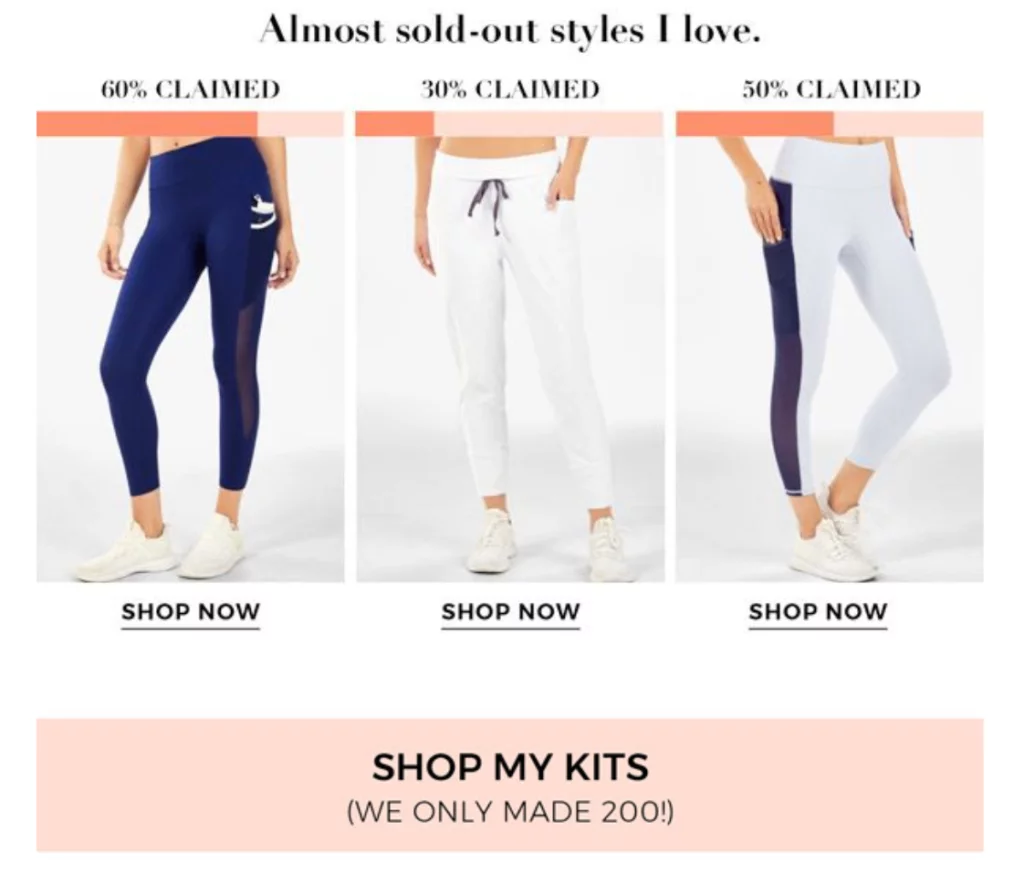
Seeing my name in the inbox compelled me to open the email almost reflexively. Who wouldn’t respond to a message personalized in such a way?
Moreover, the email hinted at something I’d likely be interested in. Coupled with the element of scarcity, I couldn’t resist clicking.
Fabletics strategically employs the number of available items in the subject line, creating an illusion of product scarcity and prompting immediate action.
In the email, Fabletics co-founder Kate Hudson highlights the limited availability of their special product line: “Fabletics Scarcity Email”.
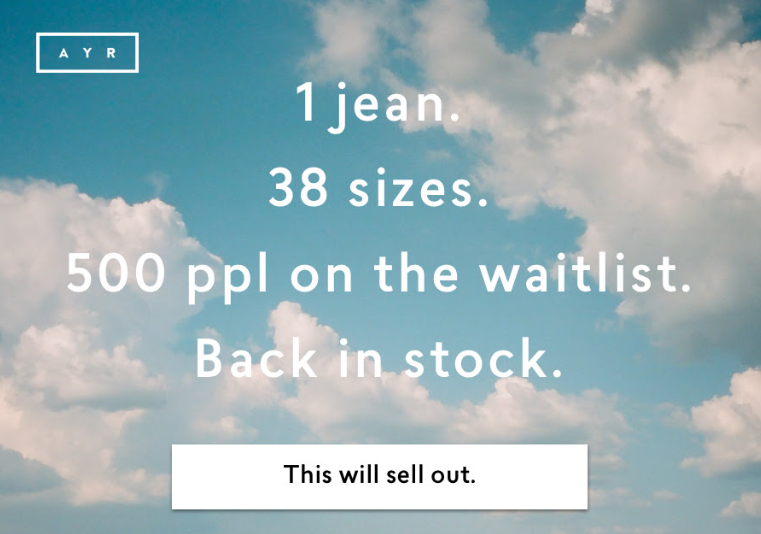
The company showcases the remaining stock percentage to underscore its popularity and scarcity.
Further amplifying the sense of scarcity, they remind subscribers that they’re “almost sold-out.”
Finally, they emphasize the limited quantity once more in their call-to-action, stating “We only made 200.”
This email masterfully integrates scarcity with other psychological triggers:
- Fabletics piques curiosity with a personalized, attention-grabbing subject line.
- The brand leverages the authority of its celebrity founder for social proof.
- They cultivate exclusivity by labeling their product category as “ultra-limited edition.”
- The scarcity of their products is reiterated multiple times throughout the email.
You may not have a celebrity co-founder, but harnessing the power of numbers to highlight product scarcity is within your reach.
2. Stir the Impending Scarcity (AYR)
Scarcity isn’t solely dictated by your inventory levels; various product attributes can induce a sense of scarcity among your prospects.
Among these, the number of people on your waitlists stands out as a potent tool to instill urgency in your emails.
Whether it’s a waitlist for items temporarily out of stock or soon-to-be-released products, revealing the number of individuals eagerly awaiting them tantalizes the prospect of scarcity.
Think back to those lines snaking around the block, filled with people waiting overnight for the latest product launch; perhaps you viewed it as a tad excessive. Yet, sometimes, the rationale is simple: securing an item before it vanishes from shelves.
This mindset is precisely what AYR taps into with their email campaigns: “AYR Scarcity Subject Line”

Initially, this assertion may seem superficial. However, upon opening the email, AYR substantiates the scarcity of the product: “AYR Scarcity Email”
AYR adeptly employs scarcity tactics in this straightforward email by:
- Notifying subscribers of past instances where the product was out of stock; and
- Presenting the waitlist count as evidence.
This approach evokes the looming possibility of sell-out. After all, if a product has sold out previously, it’s likely to fly off the shelves again.
On occasion, AYR takes it a step further by spotlighting their low-stock items in emails like this: “AYR Scarcity Email 2”

By triggering the fear of missing out (FOMO) with phrases like “Don’t live in regret,” the company forewarns that “these will sell out.”
It’s a bold strategy, but one certainly worth considering.
Learn about last chance emails.
3. Sweeten the Deal (Brooklinen)
While scarcity holds sway, it’s not always sufficient by itself to sway subscribers into becoming customers.
Introducing an incentive, like a discount code, into your scarcity-laden emails can tip prospects towards swifter purchasing decisions.
Take a glance at this email Brooklinen recently dispatched to me: “Brooklinen Scarcity Subject Line”
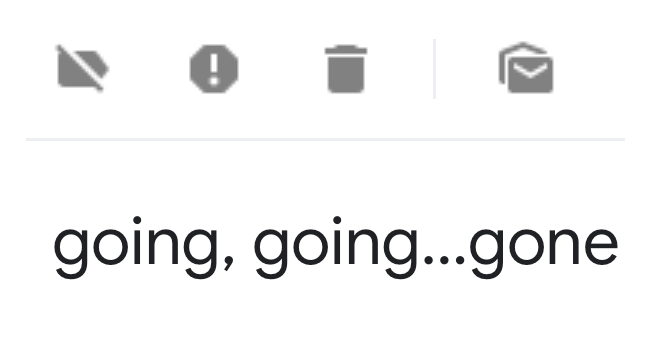
With this enigmatic subject line, they ignite urgency, then spotlight a product in the email: “Brooklinen Scarcity Email”
Launching with a stark alert “last chance!” Brooklinen’s email orbits around the scarcity of a particular product collection.
Recognizing that consumers aren’t always swayed by the “almost-out-of-stock” ploy, Brooklinen clarifies why this is the final opportunity to procure the product—simply put, they’re clearing out inventory to make way for the Spring line.
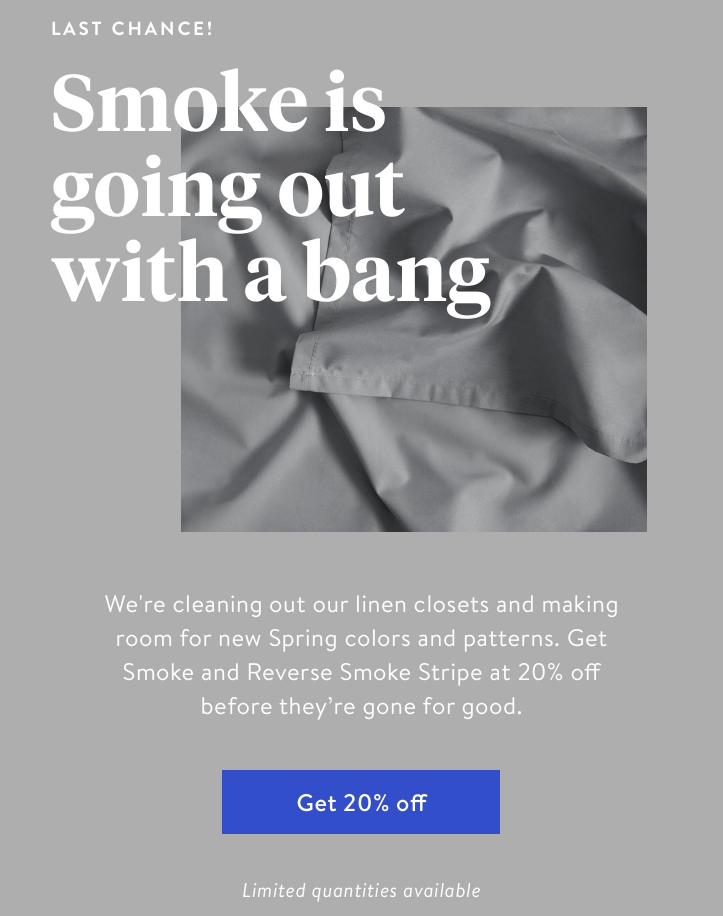
This clarion call to purchase these items “before they’re gone for good” instills a sense of urgency.
Finally, bolstering scarcity with a rational rationale, Brooklinen extends a 20% discount.
The allure of the discount code operates on two fronts, one overt and the other subtle.
The overt reason is that prospects are more inclined to purchase a product at a reduced price. The subtler rationale is that discounted products tend to sell out more swiftly.
Brooklinen wraps up the email with a benefit-centric call-to-action, underscored by a scarcity-infused reminder: “limited quantities available.”
4. Highlight the Exclusive (Mack Weldon)
While scarcity is often linked to demand or seasonal availability, there’s another aspect that brands frequently overlook: exclusivity.
Consumers are drawn to exclusive items and offers because we all desire to feel special.
Take a look at how Mack Weldon emphasizes the exclusivity of their All Black Everything Pack: “Mack Weldon Scarcity Email”.
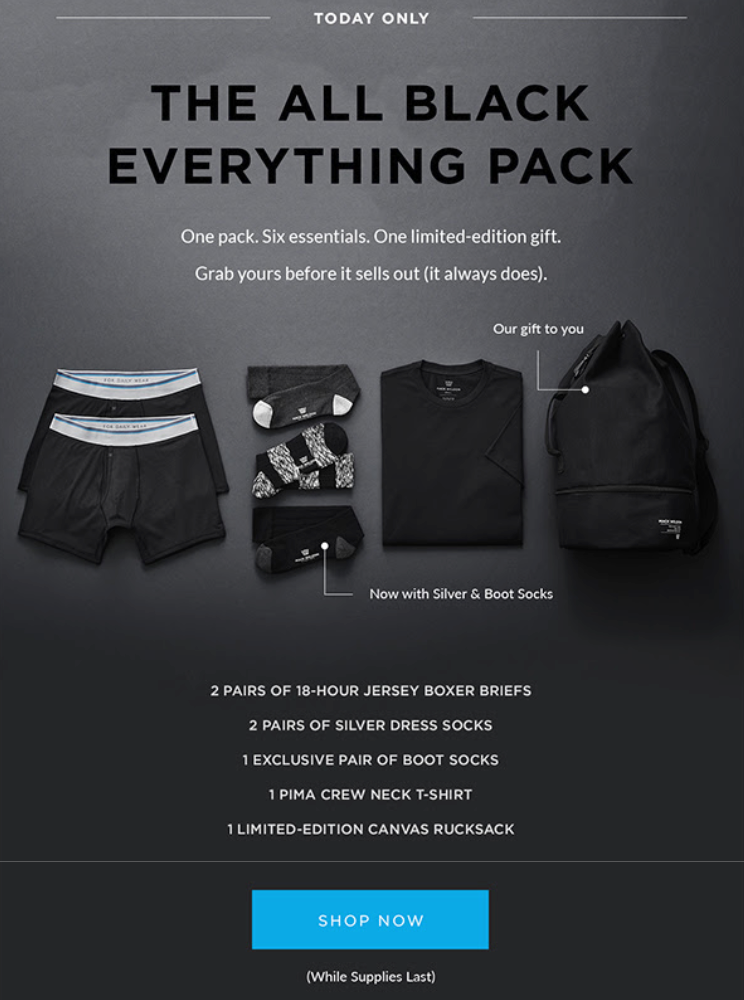
Employing a sleek black color scheme associated with sophistication and elegance, Mack Weldon communicates that this isn’t just another product. That’s why they urge you to shop now “while supplies last.”
But there’s more to it.
Observe two standout items in the pack: “1 exclusive pair of boot socks” and “1 limited-edition canvas rucksack.”
Even though the other products may be available year-round, these additions make the pack exclusive, creating a sense of urgency to acquire it before it’s gone.
Furthermore, the company encourages swift action by emphasizing urgency and scarcity. Since it’s a today-only offer, there’s little time for deliberation (or risk missing out).
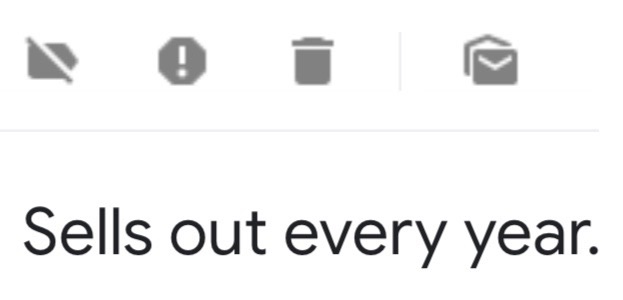
How do they know? “Mack Weldon Scarcity Subject Line”
Because it sells out every year.
If you’re still not persuaded by this time-limited, exclusive offer, they provide a compelling reason to believe that it will sell out again this year.
5. Harness the Power of Words (Ban.do)
Scarcity is a potent tool in marketing, but its effectiveness amplifies when paired with other psychological triggers like urgency, FOMO, and, most importantly, power words.
Let’s see how Ban.do masters this combination: “Ban.do Scarcity Subject Line”
This subject line is meticulously crafted, leveraging multiple triggers. It ignites urgency, hints at scarcity, and employs a magic word universally adored: free.

However, a word of caution: Urgency-inducing terms like “hurry” have become commonplace in e-commerce, potentially desensitizing consumers.
Yet, Ban.do manages to captivate attention by dangling the prospect of disappearing “free stuff,” a temptation too enticing to ignore.
Now, let’s delve into the email itself: “Ban.do Scarcity Email”.
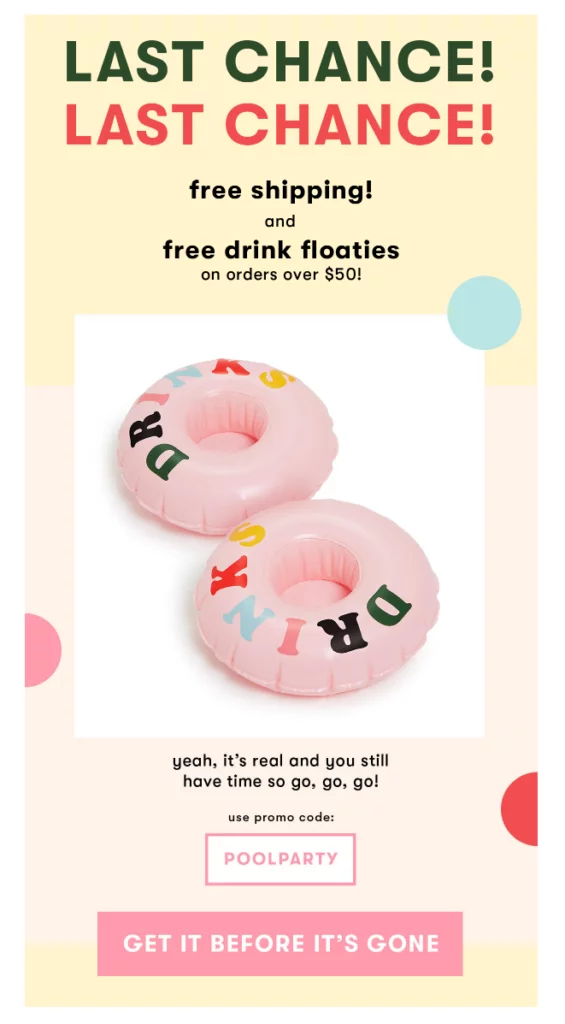
Here, the true meaning of “free stuff” is revealed: complimentary shipping and a bonus item for orders surpassing $50.
Offering complimentary items or services while accentuating their limited availability with power words proves to be a strategic maneuver, particularly when you’re reluctant to discount your products. Moreover, it entices prospects who may overlook conventional discount codes.
Lastly, Ban.do wraps up the email with a CTA button that not only urges action but also highlights the benefits, transcending the mundane “Shop Now” rhetoric.
6. Tap into Holiday Frenzy (BarkBox)
The holiday rush is a whirlwind for everyone, but it’s particularly hectic for e-commerce marketers.
If you’re running an online store, timing is everything. You need to reach out to your subscribers promptly so they can snag their gifts from you before it’s too late.
Yet, amidst the chaos, there’s a specific customer segment that becomes a veritable goldmine: the last-minute shoppers.
And here’s the beauty of it – tactics like scarcity and urgency work wonders on them.
Enter BarkBox, a master at capitalizing on the holiday frenzy with scarcity-infused emails aimed at those procrastinators: “BarkBox Subject Line”.

With a knack for injecting humor into its email marketing, BarkBox grabs the attention of procrastinators with a clever pun.
Recognizing your inevitable panic, they opt not to hard-sell. Instead, they offer reassurance, letting you know they’ve got your back.
This isn’t just a short-term strategy. BarkBox understands that you’re likely to remember and value a brand that came through for you in your time of need, potentially converting you into a lifelong customer.
Now, let’s take a peek at the adorable email: “BarkBox Scarcity Email”.

Aware that time is of the essence, they gently prod you to order your gift now and enjoy free rush shipping. Their query, “Shall we rush your Barkbox for free?” almost presents it as a selfless gesture.
Observe closely the CTA buttons BarkBox employs. The first one, “Get In Time,” not only hints at the obvious benefit of securing a gift from the company but also implies the need for immediate action.
Meanwhile, the second CTA, “Click for Peace of Mind,” zeroes in on the emotional payoff of alleviating a significant worry.
In essence, BarkBox effectively urges you to act during this critical period by emphasizing the scarcity of time and availability.
7. Introduce Pre-Launch Savings (Beardbrand)
No one relishes the thought of paying more for a product later when they could snag it at a discounted rate today.
That’s why many companies entice their subscribers with early-bird pricing, whether it’s for a book launch or the unveiling of a new product collection.
Fortunately, offering pre-launch savings inherently instills a sense of scarcity and urgency, as it’s typically either time-sensitive or limited in quantity. All that’s left is to emphasize this scarcity in your emails.
Take a cue from Beardbrand, who executes this strategy brilliantly: “Beardbrand Scarcity Email”.
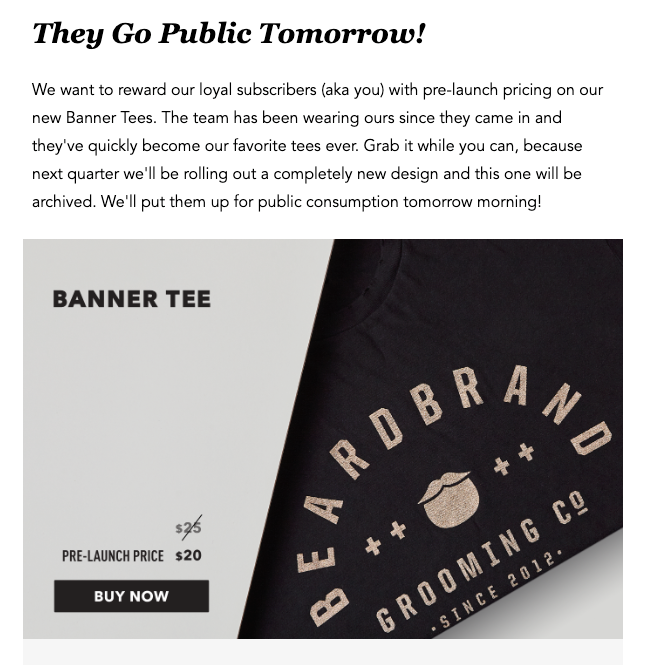
Through a subscriber-exclusive email campaign, Beardbrand treats their email list to pre-launch pricing.
Similar to Brooklinen’s approach, the company provides compelling reasons for both:
- Why the product won’t be available for long (because this design will soon be archived).
- Why it might fly off the shelves after today (because it goes public tomorrow).
There’s a shrewd pricing strategy at play here.
If you’re on the fence about purchasing this product, this offer is likely the push you need. Buy today, and it’s yours for just $20. Wait until tomorrow, and it’ll set you back $25. As a savvy consumer, the choice is clear—you’ll opt to buy now.
For this email, Beardbrand opts for a subject line that’s more subtle and less overtly sales-driven: “Beardbrand Scarcity Subject Line”.
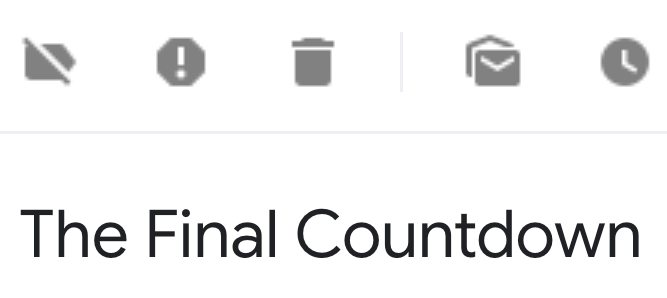
It’s a straightforward yet effective approach to promoting product launches or impending sales to your subscribers without coming across as overly pushy.
8. Encourage New Purchases with Incentives (Rifle Paper Co.)
Guiding potential customers further down your sales funnel can be challenging.
You’re likely leveraging email marketing to transition prospects from considering a purchase to making a decision. Offering discounts to first-time buyers is a common tactic, but perhaps you’re hesitant to discount your products. Maybe you believe it could diminish their perceived value or strain your budget.
In that case, consider providing something tangible to incentivize first-time purchases, enhancing it with a sense of scarcity.

Freebies are universally appealing. Like the Ban.do example mentioned earlier, Rifle Paper Co. leverages scarcity to convert subscribers into first-time buyers: “Rifle Paper Co Scarcity Subject Line”
If you’re part of the company’s email list but haven’t made a purchase yet, you’re well aware that now is an opportune moment to become a customer, as it’s the final day to claim a freebie.
Here’s a glimpse of their email: “Rifle Paper Co Scarcity Email”
This email is effective for several reasons:
- It creates urgency by imposing a time limit.
- It employs the enticing word “free.”
- It offers a limited edition freebie at checkout to drive conversions.
9. Offer Limited-Time Free Shipping (Chubbies)
Let’s acknowledge something crucial: scarcity isn’t solely about product availability or expiring discount codes. It also encompasses benefits that vanish if you don’t act promptly, like seizing an opportunity within the next few hours or being among the first few hundred customers.

While many e-commerce businesses link scarcity with discounts, standing out demands a fresh approach. Consider offering time-sensitive benefits that hold equal value if you’re not keen on giving away free products.
Conclusion:
In conclusion, contrary to popular belief, scarcity marketing extends beyond discounts. For optimal results, blend it with other psychological triggers and integrate it into your email marketing strategy. Remind your readers of the benefits they stand to lose with compelling, benefit-focused copy, and watch your conversions soar.
FAQs on Repeat Purchases:
What is the process for returning damaged items?
Providing clear instructions for returning damaged items, such as contacting customer support or submitting photographic evidence, ensures a smooth resolution process for both parties.
How will customers receive their refunds?
Clearly outlining the refund process, including the method of reimbursement (e.g., original payment method, store credit), helps alleviate any uncertainties for customers.
Where can customers obtain return labels?
Offering straightforward instructions for accessing return labels, whether through a downloadable link or an automated system, facilitates the return process and enhances customer satisfaction.



